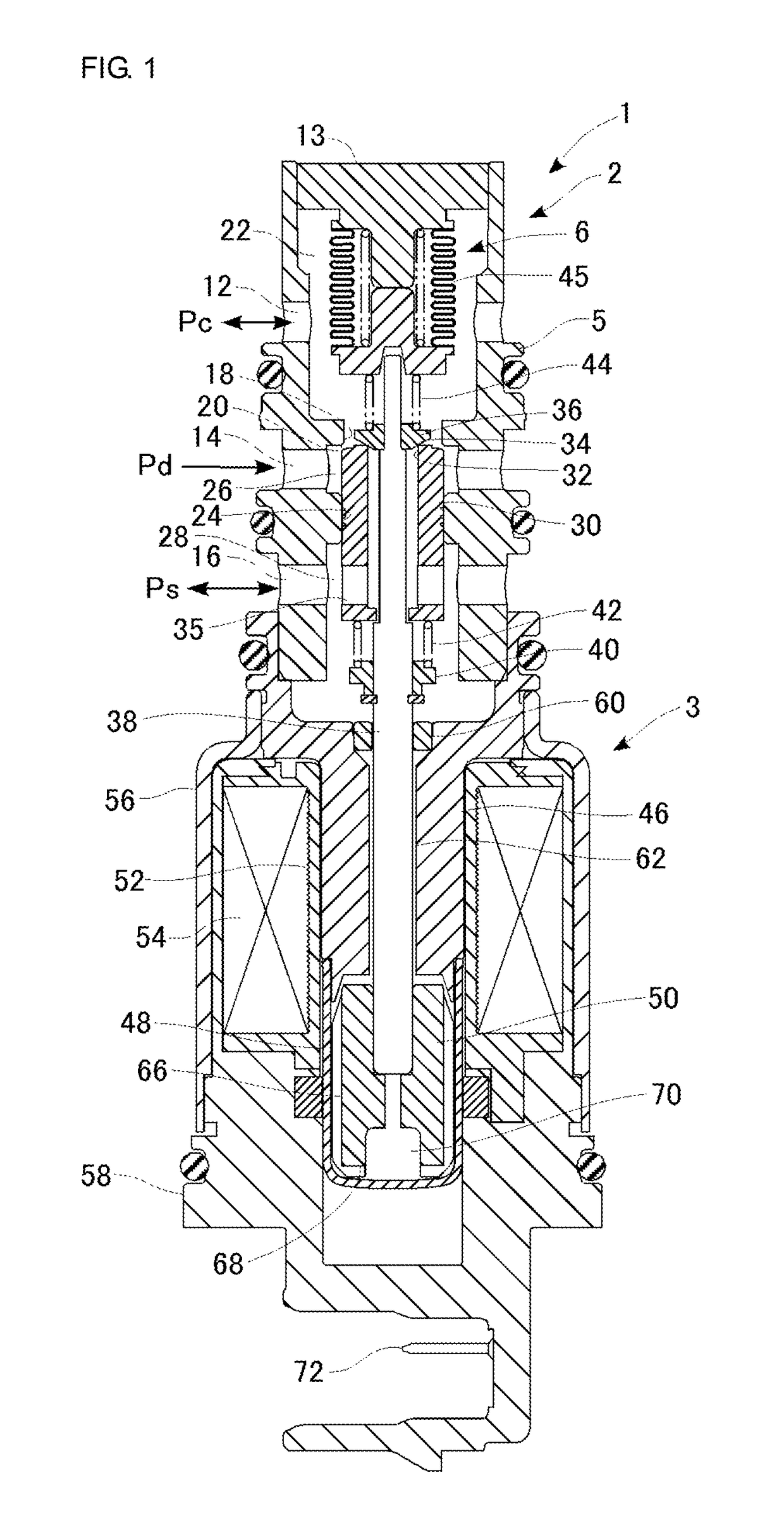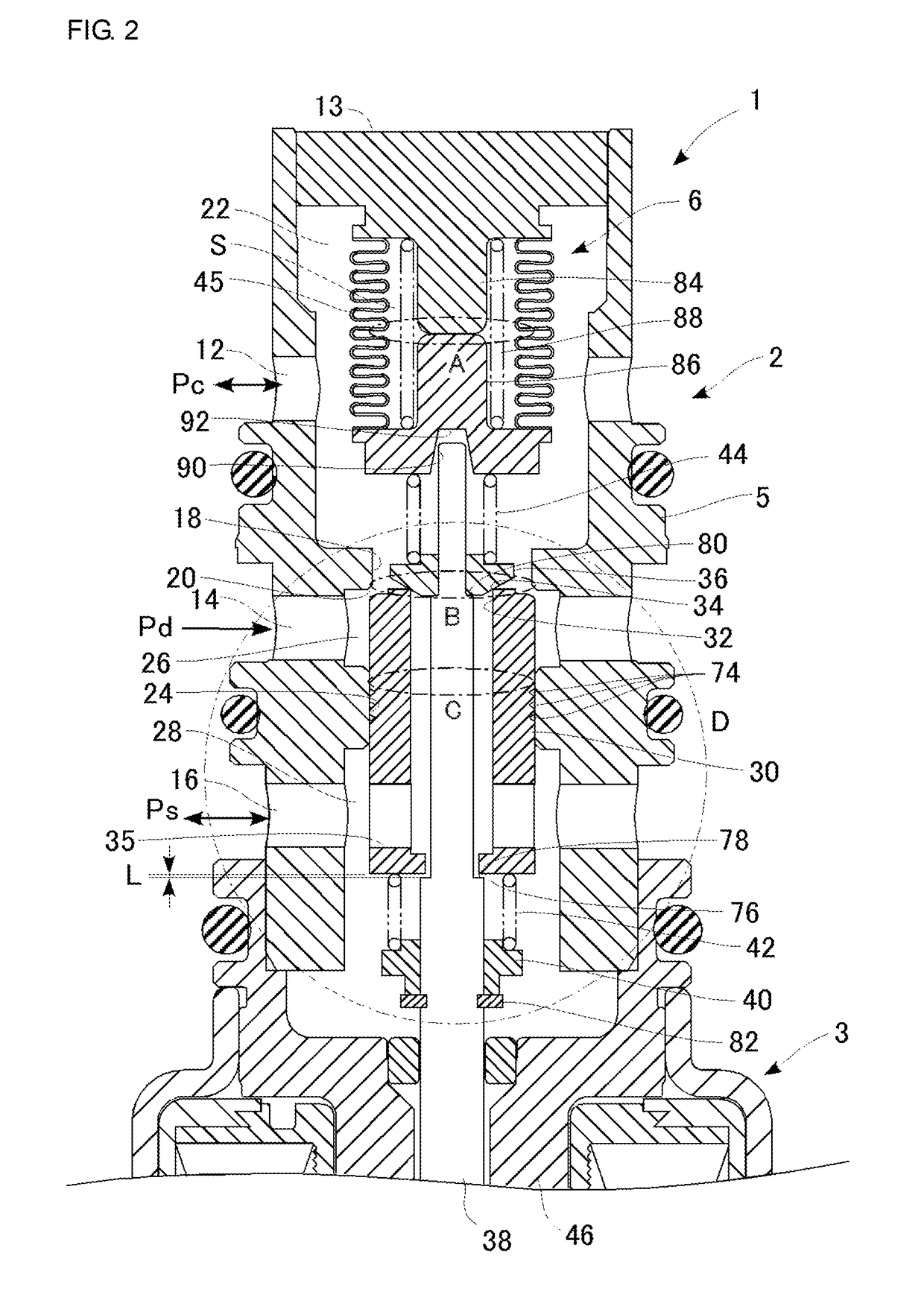Composite valve with main valve element and sub-valve element
a valve element and composite technology, applied in the field of composite valves, can solve the problems of insufficient driving force, foreign materials entering the sliding portion of the valve, and eventually locking the main valve element, and achieve the effect of reducing the load of the actuating rod and being easy to transmi
- Summary
- Abstract
- Description
- Claims
- Application Information
AI Technical Summary
Benefits of technology
Problems solved by technology
Method used
Image
Examples
first embodiment
[0031]FIG. 1 is a cross-sectional view showing a structure of a control valve according to a first embodiment. A control valve 1 is configured as an electromagnetic valve for controlling a discharging capacity of a not-shown variable displacement compressor (hereinafter referred to simply as “compressor”) installed for a refrigeration cycle of an automotive air conditioner. This compressor discharges a high-temperature and high-pressure gaseous refrigerant produced by compressing a refrigerant flowing through the refrigeration cycle. The gaseous refrigerant is then condensed by a condenser (external heat exchanger) and further adiabatically expanded by an expander so as to become a misty, low-temperature and low-pressure refrigerant. This low-temperature and low-pressure refrigerant is evaporated by an evaporator, and the evaporative latent heat cools the air of an interior of a vehicle. The refrigerant evaporated by the evaporator is again brought back to the compressor and thus ci...
second embodiment
[0069]FIG. 8 is a cross-sectional view showing a structure of a control valve according to second embodiment. FIG. 9 is a partially enlarged sectional view of the upper half of FIG. 8. The control valve according to the second embodiment differs from the first embodiment in the structure of the valve unit. Thus, a description is hereinbelow given centering around different features therefrom. Note that the structural components in FIG. 8 and FIG. 9 closely similar to those of the first embodiment are given the identical reference numerals.
[0070]As shown in FIG. 8, a control valve 201 is constituted as a Ps sensing valve. However, a power element 206 does not sense the crank pressure Pc but directly senses the suction pressure Ps, instead. The control valve 201 according to the second embodiment differs from the first embodiment in this respect. The control valve 201 is constituted by integrally assembling a valve unit 202 and a solenoid 203. In the present embodiment, too, a body 20...
third embodiment
[0078]FIG. 10 is a partially enlarged sectional view of the upper half of a control valve according to a third embodiment. The control valve according to the third embodiment differs from the first and second embodiments in the structure of the valve unit. Thus, a description is hereinbelow given centering around different features therefrom. Note that the structural components in FIG. 10 closely similar to those of the first and second embodiments are given the identical reference numerals.
[0079]A control valve 301 shares the same feature, where a power element 306 directly senses the suction pressure Ps, as the second embodiment and differs from the first and second embodiments in that the sub-valve seat 34 is provided in a housing 307 instead of in a main valve element 330. The control valve 301 is constituted by integrally assembling a valve unit 302 and a solenoid 303. In the present embodiment, too, a body 305, a housing 307, a core 346, a casing 56 and an end member 58 form a...
PUM
 Login to View More
Login to View More Abstract
Description
Claims
Application Information
 Login to View More
Login to View More - R&D
- Intellectual Property
- Life Sciences
- Materials
- Tech Scout
- Unparalleled Data Quality
- Higher Quality Content
- 60% Fewer Hallucinations
Browse by: Latest US Patents, China's latest patents, Technical Efficacy Thesaurus, Application Domain, Technology Topic, Popular Technical Reports.
© 2025 PatSnap. All rights reserved.Legal|Privacy policy|Modern Slavery Act Transparency Statement|Sitemap|About US| Contact US: help@patsnap.com



